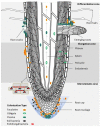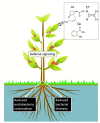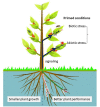Inner Plant Values: Diversity, Colonization and Benefits from Endophytic Bacteria
- PMID: 29312235
- PMCID: PMC5742157
- DOI: 10.3389/fmicb.2017.02552
Inner Plant Values: Diversity, Colonization and Benefits from Endophytic Bacteria
Abstract
One of the most exciting scientific advances in recent decades has been the realization that the diverse and immensely active microbial communities are not only 'passengers' with plants, but instead play an important role in plant growth, development and resistance to biotic and abiotic stresses. A picture is emerging where plant roots act as 'gatekeepers' to screen soil bacteria from the rhizosphere and rhizoplane. This typically results in root endophytic microbiome dominated by Proteobacteria, Actinobacteria and to a lesser extent Bacteroidetes and Firmicutes, but Acidobacteria and Gemmatimonadetes being almost depleted. A synthesis of available data suggest that motility, plant cell-wall degradation ability and reactive oxygen species scavenging seem to be crucial traits for successful endophytic colonization and establishment of bacteria. Recent studies provide solid evidence that these bacteria serve host functions such as improving of plant nutrients through acquisition of nutrients from soil and nitrogen fixation in leaves. Additionally, some endophytes can engage 'priming' plants which elicit a faster and stronger plant defense once pathogens attack. Due to these plant growth-promoting effects, endophytic bacteria are being widely explored for their use in the improvement of crop performance. Updating the insights into the mechanism of endophytic bacterial colonization and interactions with plants is an important step in potentially manipulating endophytic bacteria/microbiome for viable strategies to improve agricultural production.
Keywords: biocontrol bacteria; endophytic bacteria; plant defense signaling; plant growth promotion; plant microbiome.
Figures






References
-
- Alquéres S., Meneses C., Rouws L., Rothballer M., Baldani I., Schmid M., et al. (2013). The bacterial superoxide dismutase and glutathione reductase are crucial for endophytic colonization of rice roots by Gluconacetobacter diazotrophicus PAL5. Mol. Plant Microbe Interact. 26 937–945. 10.1094/MPMI-12-12-0286-R - DOI - PubMed
-
- Alquéres S. M., Oliveira J. H., Nogueira E. M., Guedes H. V., Oliveira P. L., Câmara F., et al. (2010). Antioxidant pathways are up-regulated during biological nitrogen fixation to prevent ROS-induced nitrogenase inhibition in Gluconacetobacter diazotrophicus. Arch. Microbiol. 192 835–841. 10.1007/s00203-010-0609-1 - DOI - PMC - PubMed
Publication types
LinkOut - more resources
Full Text Sources
Other Literature Sources

